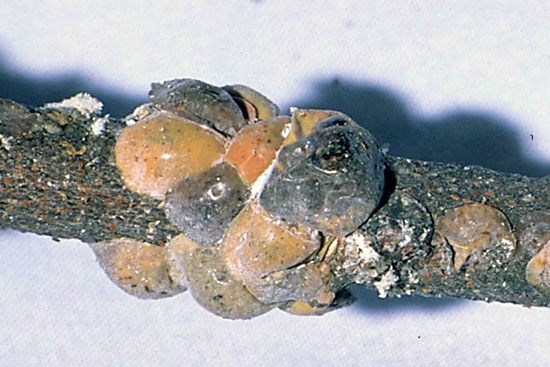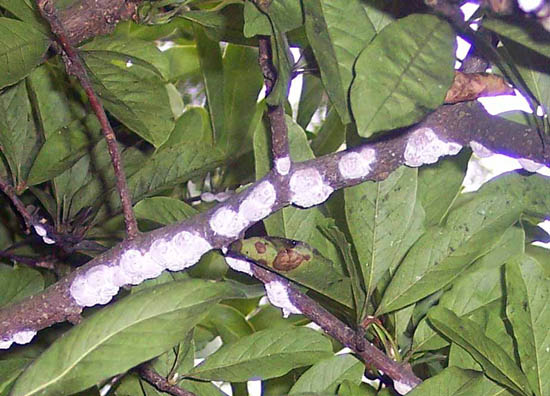Issue 11, July 7, 2015
Magnolia Scale
Magnolia scale, Neolecanium carnuparvum, is common this year in northern and central Illinois. It attacks star magnolia, Magnolia stellata; cucumbertree magnolia, M. acuminate; saucer magnolia, M. soulangiana; and lily magnolia, M. quinquepeta.
Magnolia scale females can be very large for scales, about ½ inch in diameter, but are usually smaller. They range from yellowish to brownish, from oval to a roundish blob. Magnolia scale produces large amounts of honeydew, resulting in shiny, sticky leaves, as well as sticky sidewalks and cars underneath infested trees. Black sooty mold grows on the honeydew, resulting in black branches, foliage, and sidewalks. Soft scales consume great quantities of sap, separate out much of the water and nitrogen, and excrete most of the remainder as the concentrated sap, or light syrup, called honeydew.

Magnolia scale crawlers.
Mature females produce living young in late September to early October. These first-stage nymphs, or crawlers, are oval and gray, with a reddish brown ridge running down the back. Each crawler has two white, waxy spots, one on each side. Crawlers mass on the undersides of 1- and 2-year-old twigs for the winter. From the time that they emerge from the female until they molt to the second nymphal instar in late April or early May, they are vulnerable to insecticide sprays. In early June, they molt again to the third-instar nymph stage and are deep purple.
Heavily infested twigs and branches appear purple and rough from the high scale numbers. The nymphs then produce white, powdery wax that covers their bodies, causing twigs to appear whitish in high infestations. As they mature to adults, the white wax wears away, being heaviest on the edges of the scale. There is one generation per year.

Magnolia scale on magnolia.
An insecticidal spray of acephate (Orthene), insecticidal soap, or summer spray oil in late September into October controls the crawlers. Injection of acephate (Lepitect) should also control them at that time. The same treatments at bud break in the spring are also effective. With the insecticidal soap and summer spray oil, be sure to get good coverage, particularly on the twig undersides, where the crawlers will be most numerous. As these are contact insecticides, insects not hit directly with the soap or oil spray will probably survive.
There is little control that can be achieved at this time of year. There have been some reports of success with imidacloprid (Merit, others) and dinotefuran (Safari), but the results have been inconsistent. A summer spray oil application may also provide some control, but be careful in its application. Do not increase the rate or spray when temperatures are above 80 degrees F to avoid leaf burn. Let me know your results if you try summer control. Realize that dead scale will not fall off of the tree. Summer control is determined easiest by the lack of honeydew production. (Phil Nixon)
Author:
Phil Nixon